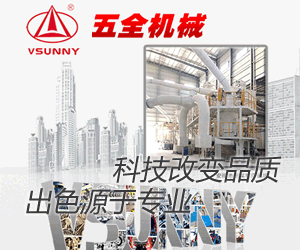砂磨机作为一种高效超细研磨设备,在铀矿开采及核能发电产业链中发挥着不可替代的作用,其应用贯穿铀矿提取、反应堆材料制备、燃料加工及核废料处理等关键环节,推动着核能产业向高效、安全、环保方向发展。
一、铀矿湿法研磨提铀
- 作用:砂磨机将破碎后的铀矿石与化学助剂(如硫酸、硝酸)搅拌混合湿法研磨至微米级颗粒,大幅提高后续浸出反应的表面积。
- 技术要点:采用耐磨材质(特殊耐辐射、耐强酸和耐磨损高分子内衬)以抵抗铀矿中石英等硬质矿物的磨损;闭环研磨系统防止放射性粉尘外泄,研磨后矿浆通过管道直接输送至浸出池;优化研磨粒度(通常≤50μm)以平衡浸出效率与能耗,铀回收率可提升20%-30%。
- 行业现状:XX,XXX铀矿已普遍采用砂磨机替代传统球磨机,能耗降低15%-20%,杜绝放射性物料外泄。
二、反应炉碳化硅(SiC)结构材料制备
- 作用:砂磨机用于制备核反应堆用碳化硅陶瓷的原料粉。SiC是第四代反应堆(如高温气冷堆)的关键锅炉架构材料。
- 技术要点:纳米级研磨(D50≤200nm)确保SiC烧结后的致密性和抗辐照性能;湿法研磨避免粉尘爆炸风险,溶剂需选用无水乙醇等非极性介质;分级系统控制粒度分布,避免粗颗粒导致烧结缺陷。
- 案例:中国HTR-PM球床模块式高温气冷堆的燃料容器架构包覆层即采用砂磨机制备的亚微米SiC粉体。
三、铀燃料球氧化锆(ZrO₂)包覆层加工
- 作用:砂磨机制备氧化锆纳米悬浮液,用于铀燃料球(如TRISO颗粒)的惰性涂层喷涂。
- 技术要点:ZrO₂粉体研磨至100-300nm以形成均匀的溶胶-凝胶涂层;添加钇(Y₂O₃)作为稳定剂,研磨后浆料的pH值需精确控制在3-4之间;砂磨机与喷雾干燥联用,实现涂层前驱体的高效制备。
- 行业标准:ASTM C833规定核级ZrO₂涂层的密度需≥95%理论密度,砂磨工艺直接影响涂层气孔率。
四、核废料玻璃陶瓷固化减容
- 作用:砂磨机将高放废料(如核废料)固化减容。
技术要点:高能砂磨使废料与玻璃形成分子级混合,降低后续熔融固化温度(从1200℃降至900℃);采用铅屏蔽型砂磨机,防止γ射线外泄,研磨介质选用氧化锆珠;最终产物体积仅为原始废料的1/5-1/10,且抗浸出性提高10²-10³倍。
- 应用:法系AREVA的AVM工艺已实现工业化,年处理能力达5000吨玻璃固化体。
突破内卷的关键创新方向
砂磨机大型化与智能化模块化:开发处理量≥50t/h的砂磨机组,集成在线粒度监测(如激光衍射仪)和AI自动调节转速。
耐辐照材料升级:采用耐腐蚀耐辐射材质研磨盘,寿命较传统材料延长3倍。
零排放设计:全封闭系统搭配放射性废水循环装置,符合IAEA GSG-6标准。混合工艺创新:砂磨机与微波浸出联用(如Denison Mines的专利技术),缩短铀提取周期40%。
砂磨机在核能领域的深度应用,正推动铀资源利用从“粗放开采”向“精准加工+废料最小化”转型,其技术壁垒高且设备附加值显著,可有效规避低端产能竞争,为核能产业的可持续发展提供有力支撑。
作者 徐亚兵 武汉力加力机械制造有限公司2025年7月23日)
Key Applications and Innovation Directions of Sand Mills in Uranium Mining and Nuclear Power Generation Industry Chain
As an efficient ultra-fine grinding equipment, sand mills play an irreplaceable role in the uranium mining and nuclear power generation industry chain. Their applications run through key links such as uranium ore extraction, reactor material preparation, fuel processing, and nuclear waste treatment, promoting the development of the nuclear energy industry towards high efficiency, safety, and environmental protection.
1. Uranium Extraction by Wet Grinding of Uranium Ore
- Function: Sand mills mix crushed uranium ore with chemical auxiliaries (such as sulfuric acid and nitric acid) for wet grinding to micron-level particles, significantly increasing the surface area for subsequent leaching reactions.
- Technical Points: Wear-resistant materials (special radiation-resistant, acid-resistant, and wear-resistant polymer linings) are used to resist wear from hard minerals like quartz in uranium ore; a closed-loop grinding system prevents radioactive dust leakage, and the ground slurry is directly transported to the leaching tank through pipelines; the grinding particle size is optimized (usually ≤50μm) to balance leaching efficiency and energy consumption, and the uranium recovery rate can be increased by 20%-30%.
- Industry Status: XX and XXX uranium mines have generally adopted sand mills to replace traditional ball mills, reducing energy consumption by 15%-20% and eliminating radioactive material leakage.
2. Preparation of Silicon Carbide (SiC) Structural Materials for Reactors
- Function: Sand mills are used to prepare raw material powders for silicon carbide ceramics used in nuclear reactors. SiC is a key boiler structure material for fourth-generation reactors (such as high-temperature gas-cooled reactors).
- Technical Points: Nanoscale grinding (D50 ≤ 200nm) ensures the compactness and radiation resistance of SiC after sintering; wet grinding avoids the risk of dust explosion, and non-polar media such as anhydrous ethanol should be used as solvents; a classification system controls the particle size distribution to avoid sintering defects caused by coarse particles.
- Case: The cladding layer of the fuel container structure of China's HTR-PM pebble-bed modular high-temperature gas-cooled reactor uses submicron SiC powder prepared by sand mills.
3. Processing of Zirconium Oxide (ZrO₂) Cladding Layer for Uranium Fuel Pellets
- Function: Sand mills prepare zirconium oxide nanosuspensions for inert coating spraying of uranium fuel pellets (such as TRISO particles).
- Technical Points: ZrO₂ powder is ground to 100-300nm to form a uniform sol-gel coating; yttrium (Y₂O₃) is added as a stabilizer, and the pH value of the slurry after grinding needs to be precisely controlled between 3-4; sand mills are combined with spray drying to achieve efficient preparation of coating precursors.
- Industry Standard: ASTM C833 stipulates that the density of nuclear-grade ZrO₂ coatings should be ≥95% of the theoretical density, and the sand grinding process directly affects the coating porosity.
4. Vitro-Ceramic Solidification and Volume Reduction of Nuclear Waste
- Function: Sand mills solidify and reduce the volume of high-level radioactive waste (such as nuclear waste).
- Technical Points: High-energy sand grinding enables molecular-level mixing of waste and glass, reducing the subsequent melting and solidification temperature (from 1200℃ to 900℃); lead-shielded sand mills are used to prevent γ-ray leakage, and zirconium oxide beads are used as grinding media; the final product volume is only 1/5-1/10 of the original waste, and the leaching resistance is increased by 10²-10³ times.
- Application: The French AREVA's AVM process has achieved industrialization, with an annual processing capacity of 5000 tons of vitrified solids.
Key Innovation Directions to Break Through Involution
- Large-scale and Intelligent Modularization of Sand Mills: Develop sand mill units with a processing capacity of ≥50t/h, integrating online particle size monitoring (such as laser diffractometers) and AI automatic speed regulation.
- Upgrade of Radiation-resistant Materials: Use corrosion-resistant and radiation-resistant grinding discs, with a service life 3 times longer than traditional materials.
- Zero-emission Design: A fully enclosed system combined with radioactive wastewater recycling devices, in line with the IAEA GSG-6 standard.
- Innovation in Hybrid Processes: The combination of sand mills and microwave leaching (such as Denison Mines' patented technology) shortens the uranium extraction cycle by 40%.
The in-depth application of sand mills in the nuclear energy field is promoting the transformation of uranium resource utilization from "extensive mining" to "precision processing + waste minimization". Its high technical barriers and significant equipment added value can effectively avoid low-end capacity competition and provide strong support for the sustainable development of the nuclear energy industry.
Author: Xu Yabing
Wuhan Lijiali Machinery Manufacturing Co., Ltd.
July 23, 2025
 54
54
 0
0- 1苏州天启高速混合机手册
- 2纳米石墨烯电镜检测
- 3纳米石墨粉粒度检测(复达)25-0630
- 4电池材料表征实践指南
- 5聚合物加工测试分析指南
- 6散量秤彩页
- 7无斗定量包装秤—毛重秤彩页
- 8电子舌在牙膏质量控制和研发的应用

- 为什么AFM、NC等期刊频繁报道多孔水凝胶的最新研究进展?
- 蓝宝石的10大应用
- 《JMST》顶刊揭秘:激光3D打印高强铝合金的“强韧协同”奥秘——协同晶粒细化策略
- NC、AFM等期刊报道银纳米线最新研究进展!
- 为什么ZIF-67的最新研究进展值得关注?
- 经典介孔分子筛SBA-15又有新进展!
- 利用蜂鸟声共振技术对穿心莲内酯纳米混悬剂的开发、表征和分子动力学模拟
- 为什么核壳复合纳米材料的研究进展值得关注?
- Development, Characterization, and Molecular Dynamics Simulation of Andrographolide Nanosuspensions Utilizing Hummer Acoustic Resonance Technology
- 苏州碳丰科技首席科学家程金生老师以本公司名义在国际上发表关于石墨烯纤维的论文《石墨烯纤维纳米复合材料的合成及氨基酸检测的分析应用》:
- 介可视·散装物料库存管理雷达全景扫描系统在料仓、堆场中的应用
- 磷酸化修饰鬼臼果多糖的制备及生物活性
- DSR论文解读:Advanced Science News 报道中科院长春应化所新型非铂催化材料研究成果
- High-throughput preparation, scale up and solidification of andrographolide nanosuspension using hummer acoustic resonance technology(纳米混悬剂制备的前瞻性技术 - 蜂鸟声共振)
- 扫描电镜优秀论文赏析|飞纳台式扫描电镜电极材料上的应用
- 扫描电镜论文赏析-干旱影响杨树叶片及次生木质部发育的分子机制


